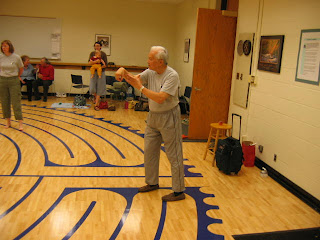What about "Tension and Relaxation"?
The picture was taken in 2006 and the video (link) was taken in 2020. In the picture Master Stephen Hwa points out that one side of his arm is firm and the other side is relaxed. You can see the student in a red shirt starting to tip from the pressure and firmness/tension of the top side of the arm. You can see the other student touching underneath and on the bottom side of the arm to sense the softness/relaxation of the underside. Master Hwa is using "internal discipline" from the body core so that his strength comes from inside the body and affects the external, namely the arm.
It is interesting that the arm "by definition is relaxed" even though the forearm exhibits "tension". This is because the entire arm does not exhibit tension but only part while the other part remains without tension or "relaxed". The arm presents "substantial/insubstantial", aka "Yin and Yang". Even more interesting is what happens when arms make contact and the body core tenses up to provide power, leaving the arm relaxed. The arm moves imperceptibly but the core movement is more noticeable in response to the push. One can say there is a "spike" of tension under external pressure and when the pressure is removed it returns to relaxed.
"The topic of "energized" and "relaxed" has been touched upon before. A relaxed body and mind is the most commonly cited benefit of Tai Chi. Students spend countless hours trying to relax their shoulders, arm, face, breathing, etc. Therefore, the word "tension" is abhorred. The word "energized" used here is partly to avoid this stigma and partly to indicate that there is an active, transforming muscle tension for a specific purpose. The energy generated from this tension is called "jin" in Chinese. When an advanced practitioner plays the Form, there is a streak of active, transforming muscle tension circulating, zigzagging in an otherwise relaxed body giving rise to the sensation of stretching and energy flow."






